Found this last Saturday while hunting one of my favorite sites. I believe this tool is from the late 1700's. It was found in the same area where we have recovered hundreds of other artifacts from the same time period. The site was featured on the cover of the August 2009 issue of W&E Treasure. I'm not sure if the protruding part was broken or not. The end appears to be fairly smooth with no rough or jagged edges. The inside has a taper that may have been used to help mount it on maybe a handle? I would appreciate any help.
Navigation
Install the app
How to install the app on iOS
Follow along with the video below to see how to install our site as a web app on your home screen.
Note: This feature may not be available in some browsers.
More options
You are using an out of date browser. It may not display this or other websites correctly.
You should upgrade or use an alternative browser.
You should upgrade or use an alternative browser.
Need help with iron tool
- Thread starter alon
- Start date
- Thread starter
- #3
I don't think so. It is pretty heavy. Most of the rein guides I've found are lighter and made of brass. The protrusion on the piece is also tapered. I'm not sure if this is clear in the pictures. The taper on the inside is the opposite of what I would expect to see on a broken pick or adze. I'm clueless. 

Upvote
0
timekiller
Silver Member
- Feb 10, 2009
- 3,852
- 964
- 🥇 Banner finds
- 1
- Detector(s) used
- Minelab E-Trac
- Primary Interest:
- All Treasure Hunting
You are right alon,with your time frame of late 1700's and being something (tool)that would mount on a shaft.I've thrown in a couple of picks of 2 plantation hoes I found last time out which would be simular in date and style of a tool mounted back then.I've not cleaned them but they taper were they mount like yours.  I also added what I think you have.
I also added what I think you have.  That is a broken tomahawk in my opinion!
That is a broken tomahawk in my opinion!  To bad it was not in one piece!
To bad it was not in one piece! 
Take Care,
Hope this Helps!
Pete
115 - GREAT CHEROKEE TOMAHAWK, A most unusual item to describe as this tomahawk dates in terms of manufacture to the late 1790's to the early 1820's. 2" X 5", hand-wrought blade of the pipe tomahawk with the added bowl missing either by use or intention. Forge marks are obvious in the blade with has a great tapered appearance (see Neumann 45A for similar style). The hardwood handle is engraved "1820 (Star) Cherokee Indian - 1941" placing the handle's dating to 1941, but the blade is absolutely early 19th Century. The handle is hardwood with some restoration and was probably a later replacement, but gives a great provenance to the Cherokee Nation. Ex-Tom Wnuck Collection........................................$495.00
 I also added what I think you have.
I also added what I think you have.  That is a broken tomahawk in my opinion!
That is a broken tomahawk in my opinion!  To bad it was not in one piece!
To bad it was not in one piece! 
Take Care,
Hope this Helps!
Pete

115 - GREAT CHEROKEE TOMAHAWK, A most unusual item to describe as this tomahawk dates in terms of manufacture to the late 1790's to the early 1820's. 2" X 5", hand-wrought blade of the pipe tomahawk with the added bowl missing either by use or intention. Forge marks are obvious in the blade with has a great tapered appearance (see Neumann 45A for similar style). The hardwood handle is engraved "1820 (Star) Cherokee Indian - 1941" placing the handle's dating to 1941, but the blade is absolutely early 19th Century. The handle is hardwood with some restoration and was probably a later replacement, but gives a great provenance to the Cherokee Nation. Ex-Tom Wnuck Collection........................................$495.00
Attachments
Upvote
0
timekiller
Silver Member
- Feb 10, 2009
- 3,852
- 964
- 🥇 Banner finds
- 1
- Detector(s) used
- Minelab E-Trac
- Primary Interest:
- All Treasure Hunting
Just to be clear on this not saying it is the exact one as what's talked about in my post but I do think it is one of some sort! 

Upvote
0
timekiller
Silver Member
- Feb 10, 2009
- 3,852
- 964
- 🥇 Banner finds
- 1
- Detector(s) used
- Minelab E-Trac
- Primary Interest:
- All Treasure Hunting
Also a GOOD guess!Old_Okie said:Looks like the eye to a broken froe to me. Used for splitting shingles and such.
 Even better then the one I was thinking to begin with had not thought of those but looking at his more and seeing that the sharp edge goes to the end I think this is it! Good ID Old_Okie
Even better then the one I was thinking to begin with had not thought of those but looking at his more and seeing that the sharp edge goes to the end I think this is it! Good ID Old_Okie Attachments
Upvote
0
- Thread starter
- #11
Those are some wonderful suggestions. One of them is probably correct. I do know that this was found in an area where some pretty intense trenching took place. I'm not too sure about a tool for digging though. I think the taper used to hold the tool in place on the handle is backwards. The protrusion on the exterior is also tapered. Any suggestions? Am I looking at this the wrong way? I really appreciate all the help.
Upvote
0
timekiller
Silver Member
- Feb 10, 2009
- 3,852
- 964
- 🥇 Banner finds
- 1
- Detector(s) used
- Minelab E-Trac
- Primary Interest:
- All Treasure Hunting
The smallest part of the hole goes on the shaft first.As afterwards I expect they would make a cross cut in the shaft to insert a wedge device to hold it on.As for the way yours is it would work best as a froe and the tapered edge of the blade faces outward.As the one I posted above if you look close you can see the sharp edge.alon said:Those are some wonderful suggestions. One of them is probably correct. I do know that this was found in an area where some pretty intense trenching took place. I'm not too sure about a tool for digging though. I think the taper used to hold the tool in place on the handle is backwards. The protrusion on the exterior is also tapered. Any suggestions? Am I looking at this the wrong way? I really appreciate all the help.
Froes
By Hank Allen
Splitting, or riving, wood in early days was a skillpracticed by craftsmen who made boards, shingles,clapboards, fences, basket splints, chair parts,wagon spokes, lath, and more. Our ancestors used axes,gluts or wedges, froes, drawknives and spelk planes forsplitting wood. The froe was designed for splitting. It is typically anL-shaped tool made up of a wedge-shaped blade with adull, but not blunt, knife edge and a wood handle. Bladeswere usually straight with a socket forged at one end, butcurved blades were also made. Most handles were roundand tapered, and were inserted up through this socket. Butsome froes had eyes similar to those on axes for handlesthat were wedged. The froe handle is held in an uprightposition in one hand while the other hand drives the top ofthe blade downward with a wood froe club or mallet.After a split is started, the froe is wiggled downward tolengthen it until the split is complete. Most old froes werehand forged, but they were also available in manycatalogs. The 1873 D.R. Barton catalog offered straightfroes at 12 1/2 cents per inch. You can still buy a newfroe from Woodcraft for $50. I couldn't find a curved froein any catalog. The following from Alex Bealer's “The Tools ThatBuilt America” takes us back in time, "Probably the firstreal organized industry in the first colony of the BritishEmpire, Virginia, was the splitting of clapboards to beexported to England. ... With no sawmills established atJamestown, splitting was the only suitable method formaking small boards." (The first sawmill in Jamestownwas burned to the ground by sawyers, which was the fateof many early sawmills in England.) Even after sawmillsobviated the need to split wood, which came earlier inNew England where sawmills were in use early on tosupport the thriving timber export trade, wood continuedto be split by hand by those who did not have access tosawmills or believed split wood to be superior for certainuses. For example, we know that rived wagon wheelspokes are stronger than sawn ones. And sometime,splitting can be faster than sawing. Bealer does notbelieve any clapboards were split after 1850. Much detail on splitting wood is contained in anotherAlex Bealer book "Old Ways Of Working Wood", one ofmy favorites. For example, cedar is the most ideal woodto split because it is amenable to splitting almost any way.Thus, a 24" cedar log can be squared with a froe and theneasily be split into shingles. An oak, pine, or chestnut log,on the other hand, must first be split by axes or wedgesinto billets (quarters for smaller logs or triangular radialsections for larger ones). For oak the useless sapwood andthe pith of the heartwood is discarded; for pine andchestnut only the bark is removed. Oak billets can then be split radially with a froe which produces boards that arewider on one edge. Thus, oak was the principal wood usedfor clapboards. Bealer says that pine and chestnut billetsmust be split tangentially to the annual rings whichproduces boards of even thickness that will not split whennailed. Herb Kean has demonstrated for me that oakboards can be rived out either radially or tangentially.
Examples of the most common froe, the straight froewith round wood handle, are shown in figure 1. Froeblades were both longer and shorter than those pictured,from 3" for the basketmaker's froe up to 24" for theshinglemaker's froe. Froes with blades 8"-12" long arecommonly called "cooper's froes", but their use by coopersis probably exaggerated. More likely, barrel stave blanksmade in the woods to be traded to the local cooper mayhave been riven out with froes. But, it's unlikely that thecooper would have used a froe for any further preparationof barrel staves. Figures 2 and 3 show a variety of curved froes,including the one in the center of Figure 2 that I wasprepared to call left-handed. But actually either curvecould be held in either hand; therefore, I'll just mentionthat froes can have different curves. What you'll hearabout curved froes is that they were used by coopers torive out curved barrel staves. Curved froes may have beenused to rive out short staves for shallow sap buckets, tubsor pails, or even kegs, but not barrel staves. Bill Rigler,who lives in Tennessee's cedar country, has split cedarwith a curved froe and tells me that curved staves comeout smooth on both sides, and for runs up to about 18".But for other woods, I quote Edwin Tunis from his bookColonial Craftsmen. " doubt that a curved froe will dowhat is hoped for it. Wood has its own ideas about howit will be split." Herb Kean tried to make some one footcurved staves from reasonably straight-grained oak. Whatresulted were staves that were curved on both sides at thevery top of the split, but, as Tunis had warned, the curvessoon gave way to the grain, and the bottoms were mostlywithout any trace of curvature. Figure 4 shows three all-iron curved froes withstraight handles. One similar to the bottom froe ispictured in The Chronicle (44:2:54) with the suggestionthat it's a cooper's froe. Figure 5 shows two froes with axe-eye sockets.Figure 6 is another axe-eye froe, but this one has a knifeedge on the end of the blade. It's a lathmaker's froe fromthis November's Brown auction. The name iscorroborated by Salaman. I couldn't find an explanationof how the edge at the end of the froe was used. If youknow, please write. Figure 7 shows three knife froes. The one with thewood handle is the only froe in my collection with amaker's mark. It was made by the Underbill Edge Tool Co.of Nashua, New Hampshire, and thus dates to 1852-90. And finally, the most unusual froe has eluded me. Ihave never seen the double-handled froe whose straightblade has a socket at each end for handles. This froe ispictured in the Crane catalog of August 1983 (it sold for$85) and also in Bud Steere's Catalog No. 29 datedDecember 1983 (priced at $110). Do you think Budbought it in August and sold it in December? Or maybehe had more than one! Anyway this froe is at the top ofmy most wanted list. Special thanks to Herb Kean and Bill Rigler for theirhelp with this article.
Attachments
Upvote
0
diggemall
Hero Member
IMHO, I think y'all are barking up the wrong tree with the idea that this was wedge-fitted to a wooden handle / shaft: the taper looks waaaaay too drastic for that.
To me, it has the look and proportions of an outer bearing race. The protrusion ? Perhaps a key of sorts to keep the outer race from turning ?
Diggem'
To me, it has the look and proportions of an outer bearing race. The protrusion ? Perhaps a key of sorts to keep the outer race from turning ?
Diggem'
Upvote
0
- Thread starter
- #14
I agree. I think the severity of taper may have more to do with it. Thank you all for your input thus far. The coins recovered from this site range in age from 1707 to 1795. There have been no newer coins found. I wish I knew where to look for more research. I'm sure this tool dates from the same era.
Upvote
0
timekiller
Silver Member
- Feb 10, 2009
- 3,852
- 964
- 🥇 Banner finds
- 1
- Detector(s) used
- Minelab E-Trac
- Primary Interest:
- All Treasure Hunting
I agree with you Lucas!Lucas said:Not the right kind of eye for a tomahawk. Froe works for me tho.
 As my hoes have the same size diameter holes as his piece!They also taper much like what I see of his piece!
As my hoes have the same size diameter holes as his piece!They also taper much like what I see of his piece!  Not much question to me what it is until someone can come up with a better Idea!
Not much question to me what it is until someone can come up with a better Idea! 

Attachments
Upvote
0
GpSnoopy
Sr. Member
- Sep 14, 2008
- 415
- 165
- Detector(s) used
- MXT, Sovereign GT, CTX 3030
- Primary Interest:
- All Treasure Hunting
I'm thinking that it may have originally come from a mattock, or froe as has been suggested, until someone else comes up with something that makes more sense.
When growing up on the farm, we used to modify a lot of tools to meet our needs, and I would think that heavy rust would hide the finer tool marks if one did a really smooth job.
A regular Mattock has too many similarities.



When growing up on the farm, we used to modify a lot of tools to meet our needs, and I would think that heavy rust would hide the finer tool marks if one did a really smooth job.
A regular Mattock has too many similarities.



Upvote
0
I would have to go with the sythe idea. It is a tapered ring to keep the blade attached to the handle. The tang is for loosening it to remove the blade/or to tighten it when attaching the blade. There's no practical use otherwise for a modified froe, pickax, or ax. I don't believe anyone would ruin a good tool for no reason.


Upvote
0
Bigcypresshunter
Gold Member
- Dec 15, 2004
- 27,000
- 3,339
- Detector(s) used
- 70's Whites TM Amphibian, HH Pulse, Ace 250
- Primary Interest:
- Beach & Shallow Water Hunting
We need a better pic on the scythe ring idea. Im going with the broken froe until someone can prove otherwise..muncle said:I would have to go with the sythe idea. It is a tapered ring to keep the blade attached to the handle. The tang is for loosening it to remove the blade/or to tighten it when attaching the blade. There's no practical use otherwise for a modified froe, pickax, or ax. I don't believe anyone would ruin a good tool for no reason.
Upvote
0
Top Member Reactions
-
 3390
3390 -
 2000
2000 -
 1936
1936 -
 1157
1157 -
 1097
1097 -
 891
891 -
 800
800 -
 797
797 -
 787
787 -
 787
787 -
 744
744 -
 535
535 -
 478
478 -
 464
464 -
 444
444 -
 422
422 -
 422
422 -
 420
420 -
E
411
-
 384
384
Users who are viewing this thread
Total: 2 (members: 0, guests: 2)


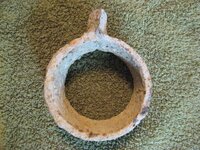
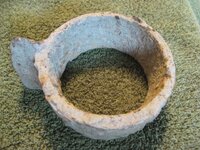
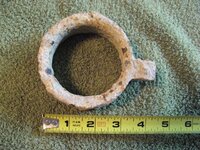
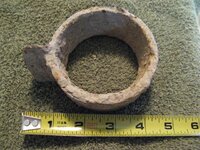
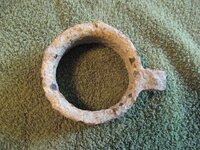
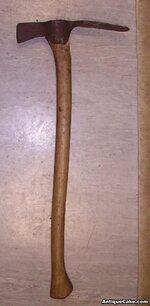
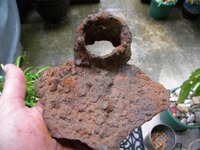
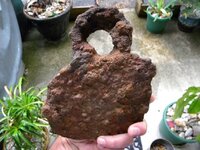
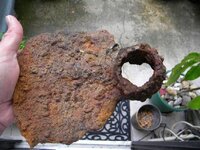
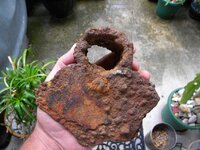
![cherokeetomahawk[1].jpg](/data/attachments/392/392595-285bd4b144e0429ff899dec98b3316a0.jpg)
![peavey_froe[1].jpg](/data/attachments/392/392873-2179677d3502158ec3ce1e160703aa7b.jpg)
![065s[1].jpg](/data/attachments/392/392875-bab294937e87fac4967e493a6cd7c93a.jpg)
![pic3[1].jpg](/data/attachments/393/393199-17a3f0a3b15388df6321b6d73125841d.jpg)
![pic2[1].jpg](/data/attachments/393/393196-38f56cef6b71d604f9d6fdae5af56346.jpg)
![pic1[1].jpg](/data/attachments/393/393193-61a9e4a64e94b404470ea974cc3d33c5.jpg)
![pic4[1].jpg](/data/attachments/393/393202-2a90d4bc6fce12aeaaf21215c04d0253.jpg)
![pic5[1].jpg](/data/attachments/393/393206-d03fc99293c06da21e3dbf6a79e06b7c.jpg)
![pic6[1].jpg](/data/attachments/393/393212-3e39ea44706cced9cbc613c68a3bdad7.jpg)
![Froe[1].jpg](/data/attachments/393/393838-569c8d7dca4aa6fe353c5acbc92ec4c0.jpg)
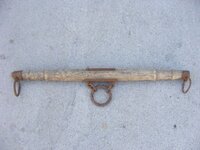
![IMG_1919[1].JPG](/data/attachments/397/397496-78f87962b59f85d1e38e871c5d8e619a.jpg)
![IMG_1922[1].JPG](/data/attachments/397/397500-f843030db75ea70140021a6635ae29eb.jpg)

